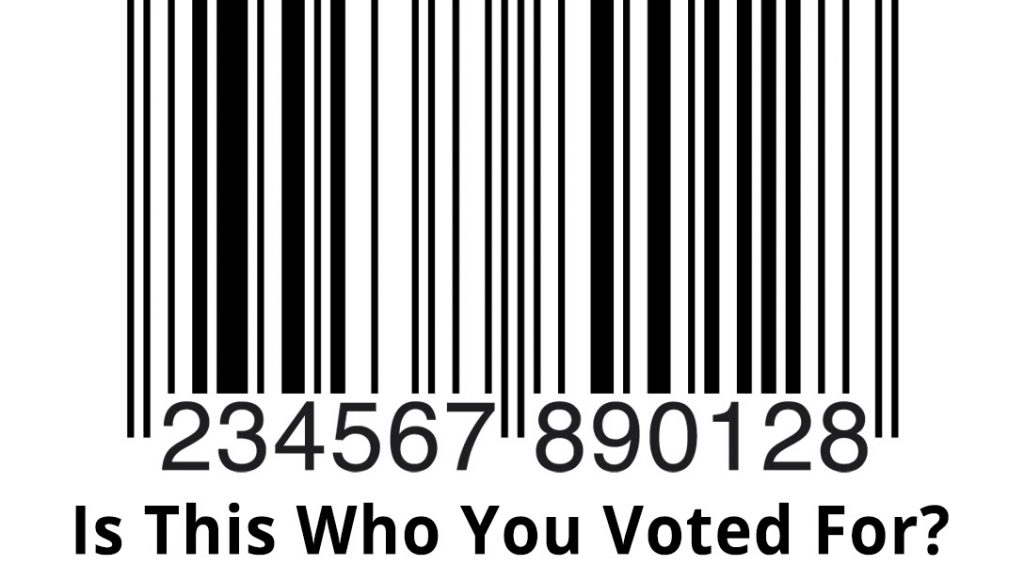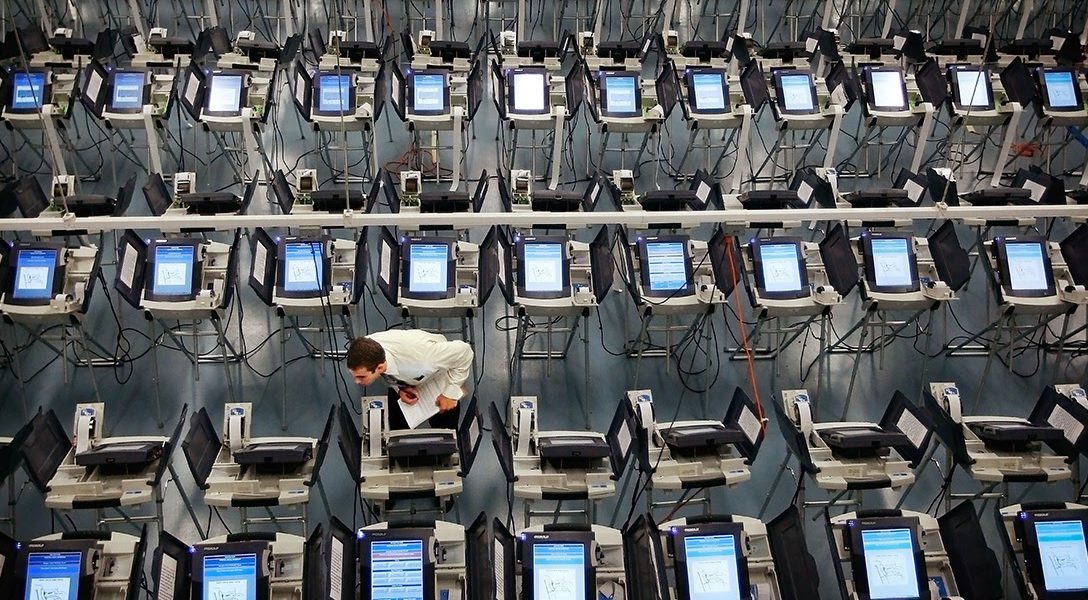Touchscreen Voting Machines and the Vanishing Black Votes
Shelby County, TN, Is New Hotspot in Battle Over Touchscreen Voting
After thousands of votes mysteriously vanished from touchscreen voting machines in Shelby County, TN, a battle rages over how to replace the machines.

Votes from predominantly black precincts have mysteriously vanished from touchscreen voting machines in both Tennessee and Georgia in recent elections. Georgia replaced the touchscreen system it had been using since 2002 with yet another controversial touchscreen system, rejecting the advice of most election security experts, who note that hand-marked paper ballots are less vulnerable to both tampering and error. A political battle is now raging in Shelby County — Tennessee’s most populous county — over whether it will follow in Georgia’s footsteps or switch to hand-marked paper ballots for the general election in November.
Shelby County is approximately 54 percent African American, a demographic that has traditionally overwhelmingly favored Democrats. But the county election commission is led by Republicans, due, in part, to state law that gives control to the party that controls the state legislature.
The loss of black votes from touchscreen voting machines in Shelby County was discovered by election commissioner Bennie Smith, a Democrat, in 2015. The debate over a new voting system has led to a knock-down, drag-out fight, pitting Smith and election security reformers against Republican election administrator Linda Phillips and other election commissioners (three Republicans and one Democrat) who recently voted to buy controversial new touchscreen voting machines called “ballot-marking devices” (BMDs) for use by most voters at the polls. Before the vote, Republicans in the Tennessee legislature wrote a letter to the Republican election commissioners, advising that they wanted them to replace the existing touchscreen system with more touchscreens (BMDs) rather than hand-marked paper ballots.
A BMD functions as an electronic ballpoint pen and marks the ballot for the voter. A separate or integrated scanner does the actual counting. Nearly all of the current generation of BMDs, including those chosen by Shelby County, record votes on paper with a barcode, which is impossible for the voter to read. In most cases, voters cannot decipher the barcodes with a smartphone, because the barcodes are proprietary to the vendor.
Richard DeMillo, an election security expert and a computer science professor at the Georgia Institute of Technology, warns that the barcode represents a new potential target for hackers since it can be altered to flip votes.

BMDs print a readable text beneath the barcode on the paper, but that text is not counted by the scanner, which instead counts the votes hidden in the barcodes. As explained by election security experts, a postelection audit comparing a manual total of the votes shown in the text to the reported electronic total can reveal problems with the ballot-counting machines (scanners), but cannot reveal whether the BMDs marked the text correctly. It’s up to individual voters to notice whether the BMD accurately represented their intention.
As indicated in a recent study co-authored by J. Alex Halderman, an election security expert at the University of Michigan, voters reported only 7 percent of errors made by BMDs. According to Halderman, “the implication of our study is that it’s extremely unsafe [to use BMDs], especially in close elections.”
Although not confirmed by the Shelby County Election Commission, local media reports state that Election Systems and Software (ES&S) will provide the county’s new BMDs. Election integrity advocates had predicted that the commission would choose ES&S, not only because ES&S maintains the county’s current system, but also because the company’s lobbyist, MNA Government Relations, shares an office with the commission’s attorney, John Ryder (who claimed during a recent meeting that his office is merely a “tenant” of MNA, that he has not discussed the “purchasing process” with MNA, and that he is not involved in that process). They also note that since 2013, ES&S has donated more than $30,000 to the Republican State Leadership Committee, whose members include Tennessee Secretary of State Tre Hargett.
Election Machines Had a Suspicious History
ES&S’s corporate history does not breed confidence that election integrity will improve. In 2000, the founder of ES&S, Bob Urosevich, was named president of Global Election Systems, which later changed its name to Diebold Election Systems and sold Shelby County its current touchscreen voting machines, the ones that lost black votes. As of September 2000, Global’s senior programmer, senior vice president, and largest shareholder was Jeffrey Dean, who had been convicted and served time for 23 counts of embezzlement involving sophisticated computer tampering. (Dean’s criminal record was exposed by Bev Harris in her book Black Box Voting: Ballot Tampering in the 21st Century.)
In 2002, Diebold Inc., an ATM manufacturer, bought Global Election Systems, rebranded it as Diebold Election Systems (DES), and chose Urosevich as its president. Diebold Inc. told the Associated Press that Dean was not affiliated with DES (formerly Global), but internal memos obtained by Harris showed that DES had kept him on as a consultant after the acquisition, and that he was called back for help on at least one occasion.
Diebold CEO Walden O’Dell was a prominent supporter of George W. Bush. In 2003, he attracted notoriety by sending a letter to potential donors stating, “I am committed to helping Ohio deliver its electoral votes to the president [Bush] … [in 2004].”
Shelby County purchased its machines from DES in 2006, just two years after the Department of Homeland Security had issued a “Cyber Bulletin” warning that Global/Diebold’s central computer, which aggregated precinct totals, was vulnerable to remote hacking. The website BradBlog.com reported the alert, which was otherwise largely ignored. A lawsuit filed several years later revealed that Shelby County’s computer did, in fact, contain remote-access software.
In 2009, ES&S bought DES. A year later, the antitrust division of the Department of Justice forced ES&S to sell some of DES’s assets, charging that the merger accounted for 70 percent of the market in US election equipment. The assets went to Dominion Voting, which conducts some of its programming in Serbia. ES&S, nevertheless, retained a number of DES servicing and maintenance contracts, including the one for voting machines in Shelby County as well as for the state of Georgia (until last year, when Georgia bought new BMDs from Dominion).
Together, ES&S and Dominion, by 2017, controlled more than 80 percent of the US election market.
In 2018, ES&S received negative press due to the revelation that it had sold election management systems (which aggregate a county or state’s precinct totals) containing remote-access software from 2000 to 2006. ES&S had previously denied selling systems with remote-access software. It now claims to have confirmed that the software was removed, but has not said how it confirmed this, whether it was removed from DES systems too, or whether it was removed before or after the 2016 election.
ES&S has also received negative media attention due to recent revelations that many of its popular precinct ballot scanners — used to count both BMD printouts and hand-marked paper ballots — have been sold with cellular modems, which send unofficial vote totals over the internet. Some of the systems on the receiving end of these transmissions have been left exposed on the internet for months and possibly years.
Consistent Voting Irregularities in Shelby County
In 2019, Bennie Smith gave a presentation during a national election integrity conference about Shelby County’s alarming history of election results. According to legal papers, for example, Republicans in Shelby swept the countywide elections in August 2010 after poll workers turned 5,400 voters away during the designated early voting period because ES&S check-in computers (electronic poll books) inaccurately reported that they had already voted. The problem allegedly occurred because the wrong database had been mistakenly inserted into the computers. Smith told WhoWhatWhy that the error disproportionately impacted Democrats because more Democrats than Republicans tend to vote early in Shelby County.
A month later, Bev Harris examined the voting records provided by county officials for that election and found 3,221 more votes than voters. Harris noted in an article published by the Columbus Free Press that most of the voterless ballots came from precincts with a heavy Republican presence. The distribution was anything but random. The inspection team obtained the documents after ten defeated candidates filed a lawsuit charging election irregularities. ES&S had the Shelby County voting machine contract at that time.
Shelby County’s election irregularities did not stop there. In 2012, election volunteers and city officials reported that 3,000 voters had been given the wrong ballots. Some voters had been turned away from the polls over challenges concerning their addresses. Others had simply given up when waiting periods were too long.
After an investigation, the state comptroller charged the Republican election commissioner, Richard Holden, as well as the county election board, with “poor judgment.” The FBI initiated an inquiry, but then dropped the case.
In August 2014, Republicans again swept nearly all the countywide elections. Nine defeated candidates filed a lawsuit charging that Diebold’s record was tainted by hackers who had conspired with the winning candidates and the election board. The case was thrown out.
In 2015, when Bennie Smith discovered the disappearance of votes from predominantly African American precincts, he documented the evidence by photographing the totals reported in poll tapes, the paper printouts generated by each machine after the polls close. He then compared the figures from the machines to the totals generated by the central computer, which revealed that votes from predominantly black precincts had been eliminated. After calls for both an investigation and the firing of Richard Holden, Holden resigned and was replaced by Linda Phillips — also a Republican.

In 2018, the Coalition for Good Governance (CGG), a nonprofit group in Georgia, decided to cross-reference poll tapes from Georgia precincts, which also used Diebold/ES&S touchscreen voting machines. It discovered that some 127,000 votes from predominantly black precincts had mysteriously vanished. The CGG filed a lawsuit, but the court later dismissed it because the Republican margin of victory was larger than the number of missing votes. In 2019, an election security panel hosted by Lulu Friesdat of SMART Elections discussed the alarming coincidence of ES&S/Diebold voting machines losing votes from predominantly black areas in both Georgia and Tennessee.
New Voting Vulnerabilities: Ballot-Marking Devices and Electronic Poll Books
Concerns with BMDs extend beyond unverifiable barcodes and auditability. Unlike hand-marked paper ballots, BMDs must be activated. Some jurisdictions accomplish this with “activation cards” prepared on electronic poll books — tablet computers that also confirm that people who check in to vote are properly registered and have not already voted. On the issue of BMD activation, ES&S’s product overview explains that a stand-alone application called ExpressLink interfaces with the electronic poll book system and a card printer to print out an activation card that the voter then inserts into the BMD to retrieve the authorized ballot.
Using electronic poll books to activate BMDs can be risky. Duncan Buell, an election security expert who serves on the faculty of the University of South Carolina, told WhoWhatWhy that “in some jurisdictions the e-poll books are connected via the internet back to home base at county headquarters. If that is the case, then one has to assume that the e-poll book is hackable and thus that the barcode is also hackable in any number of different ways.” According to Buell,
“[a] more subtle danger exists if the e-poll books are connected locally, allegedly only inside a polling place, to themselves and perhaps to printers (via wifi, bluetooth, or such). Again, the danger of hacking exists, and the problem becomes much more local and thus much harder to detect.”
DeMillo said that, to his knowledge, no one has studied the effect of inserting an activation card containing malware or other improper information (such as the voter’s party affiliation) into a BMD, which raises a number of unanswered questions about the security of the system.
Even without malware or improper hidden information, a defective activation card can cause problems. In 2016, thirty defective smart cards in Shelby County made it “impossible to pull up the correct electronic ballot on voting machines.”

There are additional concerns. If BMDs depend on electronic poll books for activation, then a connectivity issue or distributed denial of service (DDoS) attack involving the electronic poll books can prevent the use of BMDs. In a test run conducted in Georgia in January, electronic poll books from a company called Knowink failed in four out of six counties, preventing activation of the BMDs. In Indiana, ES&S electronic poll books failed due to connectivity issues in five out of seven of the counties that used them; one county clerk called it the worst election she’s ever experienced in her eight years on the job. Similarly catastrophic connectivity issues with Knowink e-poll books wreaked havoc in Los Angeles County, CA, during its recent primary.
In addition, the BMDs themselves can fail. During a recent Shelby County Election Commission hearing, Richard Garella, a Pennsylvania advocate for election integrity, read a long list of six hundred complaints from poll workers regarding Philadelphia’s new $29 million ES&S BMDs. These ranged from paper jams to screen freezes, machines not powering on, system lags, calibration issues, card errors, and machines spitting out and not reading ballots.
Brand-new BMD machines have failed during other recent election rollouts. In Richland County, SC, every fifth or sixth machine had problems. In Northampton County, PA, at least a third of ES&S’s BMDs were miscalibrated. And in Los Angeles County, CA, 20 percent of recently acquired, custom-made BMDs crashed. The Associated Press reported that, based on state certification documents in Pennsylvania, even when ES&S BMDs don’t crash, it takes the average voter three times as long to cast a vote using the BMD as it does with hand-marked paper ballots and scanners. As with all touchscreens, BMDs also limit the number of people who can vote at the same time, which leads to bottlenecks and long lines.
NAACP Sues Tennessee County Over Mismanaging Voter Registrations
Early Voting in Tennessee Hits Road Bumps Amid Registration Controversy
Compatibility Concerns With Other Equipment
Phillips hasn’t said whether the new ES&S BMDs will require the replacement of other recent election equipment purchases, which are themselves the subject of controversy due to apparent conflicts of interest involving Phillps and her family. In August of 2017, the county bought a new voter registration system from a company called Everyone Counts, which employed Phillips before she took the Shelby County job.
At least one of her sons worked for Everyone Counts when the contract was made. The county already had ES&S poll books, but in 2018 it bought new ones from Knowink — whose managing director is a former Republican election official from Missouri — after Phillips advised that only Knowink’s poll books would work with the new voter registration system. But Shelby County’s current Request for Proposal states that the county intends to replace its ES&S electronic poll books with new ones after it chooses new voting machines — which is curious given that it already bought new poll books from Knowink, where one of Phillips’s sons now works.
On the issue of compatibility, Knowink’s website lists voting-machine vendors with whom it typically partners. ES&S isn’t among them. And the city of Philadelphia recently had to shelve Knowink electronic poll books after the machines failed to connect to ES&S’s printers and proved inadequate when it came to election night reporting.
Bennie Smith has tried to steer Phillips and the election commissioners toward paper ballots marked by hand. Many security experts and election security advocates — such as Free Speech for People, Audit USA, NVRTF, CGC, SMARTelections, Scrutineers, and Citizens for Better Elections — recommend that approach. In contrast to BMDs, hand-marked paper ballots do not require activation from check-in computers and do not have compatibility issues. They don’t risk failing because of computer malware, and they can’t be improperly calibrated or programmed badly. They don’t break down or cause bottlenecks that lengthen lines, and they don’t conceal votes behind barcodes.

Moreover, a study by the University of Pittsburgh and Citizens for Better Elections found that ES&S BMDs in Pennsylvania cost almost twice as much as hand-marked paper ballots. And, according to a written analysis by the OSET Institute on election technology acquisition in Georgia, BMDs cost almost twice as much as hand-marked paper ballots over a ten-year period.
Even so, Linda Phillips and the other election commissioners voted for BMDs. Contrary to OSET’s analysis, Phillips claimed that BMDs will cost less than hand-marked paper ballots in the long run.
Despite vanishing votes in Shelby County and Georgia and frequent media reports of human error causing touchscreens to flip votes, Phillips alleges without data that people make more mistakes with ballpoint pens. She claims that, according to a study she conducted of absentee ballots, voters from certain zip codes made more mistakes than voters from other zip codes when using pens. But in response to an Open Records Request for the absentee ballots used in the study, Phillips advised that “the 1088 absentee ballots … were removed from our files as part of the routine destruction of documents. We are required to keep election materials for 22 months; then they may be destroyed. These materials do not exist.”
In any case, it is questionable whether a study examining absentee ballots is relevant to the use of paper ballots in a polling place where scanners can alert voters to over- and undervotes. During an election recount in Minnesota in 2008, a bipartisan panel found a total of only 14 out of 2.9 million hand-marked ballots in which the voter’s intention was not clear.
In contrast, it is common to see reports of vote-flipping touchscreens. Many voters are unlikely to notice the problem. Unless the vote is caught on camera, voters can’t prove that the voting machine is responsible for the problem. Election officials and vendors often blame the problem on voter error, as occurred in 2018 in Georgia and Texas. Even when a vendor admits that its employees or others incorrectly calibrated the machines, as ES&S acknowledged with BMDs that malfunctioned in Pennsylvania’s Northampton County, there is usually no remedy and no way to know whether the problem was accidental or malicious, since the software is proprietary to the vendor.
Despite the Shelby County Election Commission’s vote in favor of BMDs, the battle over the county’s voting machines is not over. While Republicans control the election commission, Democrats control the County Commission, which favors hand-marked paper ballots and controls the purse strings.
Related front page panorama photo credit: Adapted by WhoWhatWhy from Alexrk / Wikimedia (CC BY 3.0).



